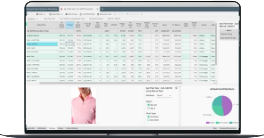What is Demand Planning? Demand planning in fashion refers to forecasting and managing the anticipated sales for fashion products in a quick-paced, trend-sensitive environment. Fast fashion retailers are known for their ability to rapidly respond to changing fashion trends and consumer preferences, often producing and delivering new styles in a matter of weeks. Demand Forecasting? in this context involves several key elements:
- Quantitative Demand Forecasting: This method relies on historical sales data and statistical analysis to predict future demand.
Techniques within quantitative forecasting include:
-
- Time Series Analysis: Analyzing historical sales data to identify patterns, trends, and seasonal variations. Methods like moving averages, exponential smoothing, and ARIMA (AutoRegressive Integrated Moving Average) models
- Seasonality and Trend Analysis: Identifying recurring patterns and trends over different time periods, such as daily, weekly, or yearly, to anticipate when specific products will be in demand.
2. Assortment Planning: Assortment planning is critical in demand forecasting. Because it directly influences what products will be available for customers. Assortment planning involves selecting the right mix of products, styles, colors, and sizes to offer to customers. This process significantly impacts customer satisfaction, sales revenue, inventory management, and overall business success. Here’s why assortment planning is essential in demand planning:
-
- Meeting Customer Preferences: Assortment planning ensures that the products offered align with the ever-changing preferences and trends of the fashion-conscious consumer. Retailers can keep their customers engaged and satisfied by having the right mix of products, styles, colors, and sizes.
- Maximizing Sales Potential: A well-planned assortment can maximize sales by offering diverse products catering to different customer segments and preferences.
- Optimizing Inventory Levels: Inventory management is one of the biggest challenges in fashion retail. Assortment planning helps retailers avoid overstocking or understocking issues. By accurately predicting the demand for different products, retailers can stock the right quantities, reducing excess inventory costs and ensuring products are available when customers want to buy.
- Minimizing Stockouts: A carefully planned assortment reduces the risk of stockouts, which occur when popular products are unavailable. Stockouts can lead to missed sales opportunities and customer dissatisfaction.
- Reducing Markdowns: Having the right assortment minimizes the need for heavy discounting or markdowns to clear out excess inventory. Protecting profit margins. A well-thought-out assortment reduces the need for such drastic measures, preserving the business’s profitability.
- Promoting Efficient Operations: A well-designed assortment supports efficient operations throughout the supply chain. It helps suppliers plan production schedules, aids in distribution, and streamlines inventory management. This results in an overall more efficient and cost-effective operation.
- Enhancing Customer Experience: When customers find products that match their preferences, they have a better shopping experience. Leading to higher customer satisfaction and repeat business.
- Supporting Marketing and Promotions: Assortment planning influences marketing campaigns and promotions. Retailers with a clear understanding of their assortment can tailor their messaging and promotions more effectively, increasing their chances of capturing the market’s attention.
- Strategic Differentiation: Assortment planning can be used as a strategic tool to differentiate a brand from its competitors. Offering unique and innovative products can set a retailer apart and attract a dedicated customer base.
- Allocation: Proper assortment planning ensures that resources are allocated efficiently across various stages, from design and production to marketing and distribution. This prevents unnecessary investment in products that might not resonate with customers and focuses resources where they’ll have the most impact.
In summary, assortment planning isn’t just about deciding which products to stock; it’s a strategic process that impacts every facet of a fashion retailer’s operations. Assortment Planning bridges customer preferences and operational efficiency, ultimately contributing to a successful and profitable fashion business.
3. Trend Analysis: Fast fashion driven by emerging trends and styles.
Here are some standard Trend forecasts and analyses used in fast fashion
Qualitative Forecasting: Qualitative methods involve subjective judgment and expert opinions. Qualitative forecasting is used to complement quantitative approaches in the fast fashion industry.
Methods include:
-
- Market Research: Conduct surveys, focus groups, and consumer interviews to gather insights about upcoming trends and consumer preferences.
- Expert Opinion: Consulting with fashion designers, stylists, industry experts, and trend analysts to gain insights into the latest fashion trends and predictions.
- Delphi Method: Collecting opinions from a panel of experts and refining forecasts through multiple rounds of discussion and feedback.
- Market Trends and Consumer Behavior Analysis: Retailers track consumer behavior and monitor market trends through social media, online fashion platforms, and other sources to gain insights into emerging fashion preferences.
Many fast fashion retailers combine these methods to create a more comprehensive and accurate forecasting strategy. The industry’s dynamic nature requires flexibility and the ability to adapt to rapid trends and consumer preference changes.






















